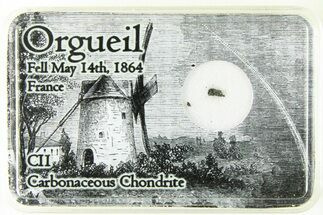.06" L6 Chondrite Meteorite Fragment - Wold Cottage
This is a .06" wide fragment of the L6 chondrite known as Wold Cottage, a witnessed fall in Yorkshire in 1795 and one of the first meteorites ever thoroughly studied. Most of this meteorite is preserved in academic collections for research: it's quite rare to find this on the market!
The Famous Wold Cottage Meteorite
This is quite a historic meteorite! This L6 chondrite fell near the village of Wold Newton in Yorkshire, England, at just about 3:00PM on December 13, 1795. It left a yard-wide crater in the ground, embedding itself into the chalk layer over 12 inches below the surface. In fact, it only landed a few yards from plowman John Shipley! The landowner, Major Edward Topham, exhibited the meteorite in London for a while before it changed hands and evnetualyl found its way to the British Museum in 1835. Today the meteorite is housed in London's Natural History Museum, and a small brick monument marks the site of its fall in Yorkshire.
The 25-kilogram mass is composed of stony portions similar to kaolin with inclusions of nickel-iron alloys and even some pyrites. It remains the largest witnessed fall in Britain and the second-largest witnessed fall in Europe.
This is quite a historic meteorite! This L6 chondrite fell near the village of Wold Newton in Yorkshire, England, at just about 3:00PM on December 13, 1795. It left a yard-wide crater in the ground, embedding itself into the chalk layer over 12 inches below the surface. In fact, it only landed a few yards from plowman John Shipley! The landowner, Major Edward Topham, exhibited the meteorite in London for a while before it changed hands and evnetualyl found its way to the British Museum in 1835. Today the meteorite is housed in London's Natural History Museum, and a small brick monument marks the site of its fall in Yorkshire.
The 25-kilogram mass is composed of stony portions similar to kaolin with inclusions of nickel-iron alloys and even some pyrites. It remains the largest witnessed fall in Britain and the second-largest witnessed fall in Europe.
About L6 Chondrite Meteorites
An L6 chondrite meteorite is a type of stony meteorite belonging to the ordinary chondrite group, the most common category of meteorites found on Earth. The "L" designation indicates that it has a relatively low total iron content, typically about 7-11%, with iron present in the form of metal grains and sulfides. The "6" refers to its petrologic type, which signifies the extent of thermal metamorphism it has undergone. As a type 6 meteorite, an L6 chondrite has been extensively heated, resulting in the complete recrystallization of its original components. This process has homogenized its mineral grains and largely obliterated the distinct chondrules (small, spherical mineral grains) that characterize less thermally altered chondrites.
L6 chondrites are composed primarily of silicate minerals like olivine and pyroxene, along with metal grains and sulfides. Their texture is relatively uniform due to the high degree of thermal metamorphism, giving them a more consistent appearance compared to less processed meteorites. Visually, they are often gray to brown in color and may display a smooth fusion crust, formed as the outer surface melted during their fiery entry into Earth's atmosphere.
The L chondrite group is thought to originate from a specific parent body in the asteroid belt that underwent a significant collisional event. This impact likely ejected vast amounts of L chondritic material into space, leading to the high prevalence of L chondrites discovered on Earth. It is believed this collision event happened approximately 470 million years ago.
An L6 chondrite meteorite is a type of stony meteorite belonging to the ordinary chondrite group, the most common category of meteorites found on Earth. The "L" designation indicates that it has a relatively low total iron content, typically about 7-11%, with iron present in the form of metal grains and sulfides. The "6" refers to its petrologic type, which signifies the extent of thermal metamorphism it has undergone. As a type 6 meteorite, an L6 chondrite has been extensively heated, resulting in the complete recrystallization of its original components. This process has homogenized its mineral grains and largely obliterated the distinct chondrules (small, spherical mineral grains) that characterize less thermally altered chondrites.
L6 chondrites are composed primarily of silicate minerals like olivine and pyroxene, along with metal grains and sulfides. Their texture is relatively uniform due to the high degree of thermal metamorphism, giving them a more consistent appearance compared to less processed meteorites. Visually, they are often gray to brown in color and may display a smooth fusion crust, formed as the outer surface melted during their fiery entry into Earth's atmosphere.
The L chondrite group is thought to originate from a specific parent body in the asteroid belt that underwent a significant collisional event. This impact likely ejected vast amounts of L chondritic material into space, leading to the high prevalence of L chondrites discovered on Earth. It is believed this collision event happened approximately 470 million years ago.
$59
TYPE
Ordinary Chondrite (L6)
LOCATION
Wold Newton, Yorkshire, England
SIZE
.06" wide
CATEGORY
ITEM
#285347
 Reviews
Reviews









